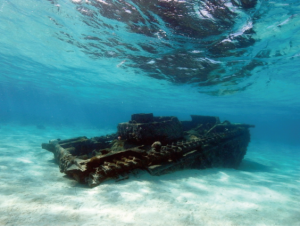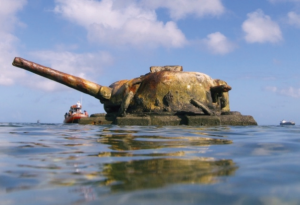
The development of a WWII heritage project originated in 2007 during conversations with the Commonwealth of the Northern Mariana Islands’s (CNMI) Historic Preservation Office. At that time, the HPO was interested in developing an underwater program or division that dealt specifically with underwater heritage. It was determined that an underwater or maritime heritage trail would promote tourism, in particular eco- and heritage tourism, public outreach and education, and the preservation of Saipan’s World War II maritime heritage. Local and descendant communities, CNMI agencies, researchers from the nonprofit organization Ships of Exploration and Discovery Research, Inc. (Ships), Flinders University, and other collaborators contributed to the creation of the WWII maritime heritage trail. The work, which started in 2009, was partially funded through two National Park Service (NPS) American Battlefield Protection Program (ABPP) grants and a National Oceanic and Atmospheric Administration’s (NOAA) Pacific Region Grants Cooperative grant, as well as a tremendous amount of in-kind support and funding on and off island.

The WWII Maritime Heritage Trail: Battle of Saipan was established in 2011. The trail consists of nine stops with a total of twelve vehicles, including US Sherman tanks, Japanese landing craft, Japanese and US aircraft, a possible Japanese submarine chaser, a US Landing Vehicle Tracked (LVT), and a Japanese freighter. Their locations vary from near shore in shallow water (2–3 ft.) to 30 ft. of water on the barrier reef. Some of the sites can be accessed from shore via snorkel, making it accessible to those who are not scuba certified. Site selection was informed by consulting with the diving industry as well as diversity in vehicle type and country affiliation (i.e., Japanese and US). Currently, Jack “Gus” Adamson is researching the PBM Mariner in Tanapag Lagoon for his Master’s thesis.
Terrestrial archaeology by its nature often public; sites are open and can be visible, visitors can look and ask archaeologists questions. On the other hand, underwater archaeology is often hidden from most of the public; sites are not visible from shore and are only accessible via boat and SCUBA. To widely share information regarding the WWII Battle of Saipan sites, the interpretive film WWII Maritime Heritage Trail: Battle of Saipan was produced. The film had two main goals: to educate the community and visiting tourists about underwater cultural heritage and to encourage its appreciation and preservation. The film captures the story of the battle through the sites scattered across Saipan’s seabed including aircraft, tanks, landing vehicles, and ships while highlighting the stories of multiple participants during the battle. The viewer goes on an underwater virtual tour of the sites that comprise the trail. The film is available at the NPS American Memorial Park Visitor Center It is also available in 3D.
Information for this trail can be viewed on posters, underwater guides, a heritage trail website, and an interpretive film. Information about the development of this trail can be found in the 2011 grant report, as well as academic publications including this journal article, this conference paper, and this conference paper.
